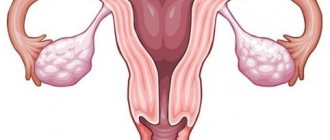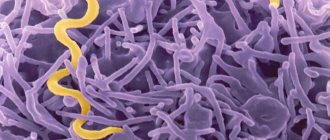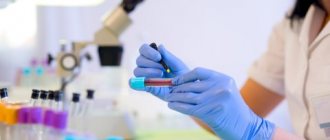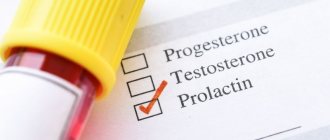Indications for chlamydia testing
The causative agent of chlamydia is Chlamydia trachomatis, a non-motile coccal bacterium with virus-like activity.
During evolution, it has lost the ability to function independently (a number of metabolic functions have been lost), therefore it exhibits its pathogenic effect only when it enters the cell. The pathogen is transmitted primarily through sexual contact, but not only adult men and women, but also children are susceptible to the disease.
Main routes of infection:
- through sexual contact;
- in everyday life (chlamydia lives up to 2 days in a humid environment at a temperature of 19-20C);
- during pregnancy and during childbirth.
REFERENCE! Chlamydia is characterized by a two-phase life cycle: a spore-like elementary body (an extracellular resting L-form) and a reticular body (a vitally active intracellular form capable of reproduction). While the reticular form is sensitive to antibiotic therapy, the spore form does not respond to treatment and is the main cause of chronic chlamydia.
For a long time the infection is asymptomatic. The latent period can be months or even years. In the later stages, the disease can provoke serious pathologies of the genital area, including infertility:
- In women, chlamydia first affects endometrial cells, then spreads to the fallopian tubes and ovaries. Over time, this provokes an adhesive process in the pelvic area, regular miscarriages, premature birth, neoplasms, and ectopic pregnancy.
- In men, the infection affects the lower parts of the urinary system (urethra and ureters), then spreads to the prostate gland and testes; Prostatitis and impotence develop.
ATTENTION! The practice of anal sex when infected with chlamydia can lead to the development of proctitis (manifested by painful sensations in the rectum).
In the absence of timely treatment, the disease “rises” to the abdominal organs. There are cases where advanced chlamydia became the cause of chlamydial pneumonia. In men, this type of infection is often accompanied by Reiter's syndrome - a combined autoimmune lesion of the conjunctiva, joints and genitourinary organs (70% of cases).
IMPORTANT! At high concentrations, the microorganism can “travel” in the human body through lymphatic and blood vessels, affecting not only organs adjacent to the source of infection, but also structures remote from it - joints, throat and even the brain (neurochlamydia). Other complications of chlamydia include: damage to the cardiovascular system, adnexitis, conjunctivitis, and infectious arthritis.
For this reason, it is advisable to undergo testing for chlamydia regularly - once a year. For men and women, a diagnostic test is prescribed as part of routine examinations, if a urogenital infection is suspected, or during an examination when planning pregnancy.
Reasons for urgent analysis may be:
- unprotected sexual intercourse with an unverified partner;
- pain in the pelvic area;
- regular miscarriages and infertility of unknown etiology;
- conjunctivitis or pulmonary inflammation (mainly in newborns).
The main symptoms of chlamydia : low-grade fever, weakness, fatigue, transparent “glassy” discharge (often with purulent inclusions), discomfort when urinating, pain in the pelvic area radiating to the lower back, swelling and tenderness of the scrotum and external urethral opening (in men ), mucous membrane of the labia (in women).
ATTENTION! Suspicion of a latent infection (including chlamydia) can be identified based on the results of a general analysis. An increase in ESR and leukocytes indicates the presence of inflammation and pathogenic infection.
What does infection lead to?
Chlamydia trachomatis are parasites located intracellularly in the epithelium of the genitourinary tract. Such parasitism leads to prolonged infection, since the disease does not manifest clinical symptoms.
Antibodies to chlamydia appear in the body. This leads to damage not only to the urogenital tract, but also to the joints, heart and internal organs. Infection occurs instantly through unprotected sexual contact if one of the partners is infected. Next, the parasites penetrate the epithelium and multiply intensively.
An acute infection occurs, which is often accompanied by painful symptoms:
- burning sensation when urinating
- pain in the lower abdomen
- decreased libido
- unpleasant discharge from the genital tract
- discomfort during sexual intercourse
- general intoxication (rare)
But not only the genitourinary tract is affected. Problems with the organ of vision and joints often occur.
With long-term persistence of chlamydia, contractures of large joints may develop, which leads to a sharp decrease in the quality of life. In addition, chlamydia is often associated with infertility and impotence. Therefore, identifying microorganisms is an important goal for maintaining health for many years.
Types of tests for chlamydia
Chlamydia is difficult to diagnose. Reasons: intracellular localization and features of the biological cycle. An accurate diagnosis requires a step-by-step and comprehensive examination.
Blood, urine, smear or scraping (of the vagina and cervical canal in women; urethra in men), saliva, ejaculate, and conjunctival fluid are used as biomaterials.
Modern diagnostic methods:
- Cytoscopy of the obtained material (smear, scraping) using acetone and methanol reagents makes it possible to identify brightly colored chlamydia under a microscope. The effectiveness of the method is low (10-15%); the positive effect appears only in the acute phase of chlamydia.
- Bakposewing is a method of cultural selection of biological material on nutrient media. Helps assess the level of sensitivity to antibiotics to create an individual treatment regimen. Cellular material taken from the patient, infected with chlamydia, is placed on a nutrient medium with the addition of an antibiotic and the reaction is observed for 5 days. The success rate of this approach is 90%.
- Immunofluorescence reaction (IFR) : an immunomorphology method isolates foreign antigens treated with fluorochromes under a fluorescent microscope. It is based on differences in the brightness of the glow of various antibodies against the background of the cell cytoplasm. The accuracy of the study is 50-70%. Relevant only for acute or long-term chronic forms of chlamydia.
- Enzyme-linked immunosorbent assay (ELISA) determines the level of immunoglobulins (ratio of IgG, IgM, IgA) and the stage of development of the pathogenic process (acute, chronic). It is able to detect antibodies to foreign pathogens at low concentrations in the blood, therefore it is indicative even in cases where the microorganism itself is not detected (a common occurrence with chlamydia). The reliability of the results is 60%.
- The polymerase chain reaction (PCR) method is capable of calculating the strain of the direct pathogen using the method of multiplying the existing DNA or RNA of the microorganism. Detects pathology in both acute and latent forms; with high accuracy diagnoses the disease with mild symptoms. The method works even with single cells with an accuracy of more than 95%.
REFERENCE! PCR is the most accurate diagnostic method. It determines not only the species of chlamydia (Chlamydia trachomatis is the most common type of the 4 known), but also its serotype (tendency to damage a particular organ).
A combined approach is often used. By combining several methods, you can achieve greater reliability of the result. In this case, the list of tests is compiled in accordance with the patient’s individual medical history.
What tests need to be taken: pros and cons of diagnosis
There are three options for testing for chlamydia: bacterial culture, ELISA and PCR. They all have pros, cons, and are accurate to varying degrees, so it's ideal to undergo due diligence.
A blood test for chlamydia is required. This analysis is considered more reliable than the bacteriological study of scrapings and smears. PCR analysis and ELISA are also performed.
ELISA for chlamydia - 60% confidence
ELISA is an effective enzyme-linked immunosorbent assay that tests the patient's blood for antibodies to chlamydia. Decoding the analysis allows you to determine whether the patient was infected with chlamydia and whether the infection is active in his body.
ELISA detects IgM, IgG, IgA antibodies to chlamydia in the blood. The body produces these immunoglobulins in response to infection. The main advantage of the ELISA analysis is the ability not only to determine the causative agent of the disease, but also to establish the stage of development of the infection - chronic or acute.
The first antibodies appear in a person’s blood already on approximately 10-20 days of illness. Then other immunoglobulins develop, indicating re-infection or chronic chlamydia. The main disadvantage of ELISA is the likelihood of error, since the accuracy of this test for chlamydia is about 60%.
PCR diagnostics - 99%
This test is the most effective and accurate method for detecting chlamydia. PCR analysis examines DNA multiplied several times. The increased degree of sensitivity of the reaction makes it possible to determine both acute and latent chlamydia, which develops in a chronic latent form.
The PCR method as a means of detecting chlamydia has many advantages. The analysis allows you to detect asymptomatic infection and is characterized by high accuracy (99%). However, false-positive results still occur. Therefore, if chlamydia is suspected, this method of examination should be combined with others.
Cultural method (bacterial inoculation) - 100 or 50% confidence
This test determines the sensitivity of the infection to antibiotics. To detect chlamydia in the laboratory, biological material taken from the patient is grown in a specific environment. The features inherent in a particular pathogen are studied.
The main disadvantages of the cultural method are the length of time it takes to wait for results and the high cost. At the same time, this technique guarantees one hundred percent accuracy of a positive result. Unfortunately, this does not apply to chronic chlamydia. It is established by culture in only 50% of cases.
A set of tests for chlamydia will allow you to form a complete picture of the disease and select an individual treatment program for a particular patient.
How to test for chlamydia
Testing for chlamydia in men and women is done in a similar way. The only obvious difference is the collection of a smear or scraping (in this case, the procedure takes into account the physiological characteristics of the patient).
The most reliable biomaterial for research is blood. It is taken from a vein in a treatment room using sterile disposable instruments, observing antiseptic rules.
Cervical, vaginal or urethral smears/scrapings provide biomaterial for microscopy and bacterial culture. They are taken at an appointment with a gynecologist (women) or urologist (men), using special sterile brushes or tampons.
Urine sediment for bacterial culture or PCR is obtained from morning urine (middle portion).
REFERENCE! In rare and severe cases, synovial fluid is used to detect chlamydia. To do this, a puncture of the joint capsule is performed in the area of large joints (knee, elbow, pelvis). The main condition for this intervention is complete sterility. This test is part of a study for osteoporosis, arthritis or arthrosis.
.To obtain a reliable result, you will need to follow universal recommendations, namely:
- stop taking potent drugs (before culture, antibiotics of any class should be stopped at least 1 month before the test; in all other cases - 14 days);
- when taking a smear a week, cancel any vaginal products;
- for 1-2 days, eliminate alcohol, diagnostic and therapeutic physiotherapy procedures, sexual contacts and the use of stimulants;
- per day you need to give up fatty foods, marinades, smoked meats and hot spices;
- the day before taking smears and scrapings, refrain from using antibacterial hygiene products;
- last meal - 6-8 hours before blood collection; the last “smoke break” is 1 hour before the procedure;
- take the test in the morning on an empty stomach;
- visiting the toilet no later than 2 hours before taking a urine test.
ATTENTION! The test is not taken during menstruation, or for 4-5 days after.
Violation of these requirements leads to an erroneous result and the prescription of an incorrect treatment regimen.
In some cases (a questionable result of a previous analysis), doctors may prescribe a provocation (drinking alcohol or special drugs). The procedure simulates the impact of an unfavorable environmental factor to enhance the manifestations of chlamydia.
Decoding the chlamydia test
The final result is presented in the form of a table. Decoding indicators has its own subtleties and requires the mandatory participation of specialists. An attempt to draw independent conclusions in this case is inappropriate.
Culture results:
- the exact name of the pathogenic agent (the species of chlamydia and its serotype are specified);
- concentration in the volume of material (measured in CFU/ml); a value above 103 CFU/ml indicates the presence of an inflammatory process;
- list of antibiotics tested for chlamydia, marked “S” (susceptible) and “R” (resistant).
PCR results for qualitative analysis:
- positive (chlamydia detected);
- negative (no chlamydia detected).
ELISA results:
- "positively";
- “doubtful”;
- “negative”.
The stage of the disease (chronic, acute, remission) is indicated by the level of certain immunoglobulins:
- IgM—an indicator of the acute stage; appear in the body 3-5 days after infection and reach peak values by the 10th day (after 3 months of circulation in the bloodstream, IgM may completely disappear);
- IgG - appear 15-20 days after infection and reach their peak levels by the 3rd month of the disease.
For ease of understanding, the ELISA results can be presented in table form:
| Index | Decoding |
| IgM-, IgG- | The pathogen is absent |
| IgM-, IgG+ | State of remission after suffering from chlamydia |
| IgM+, IgG- | Acute form of chlamydia during primary infection |
| IgM+, IgG+ | Exacerbation of chronic chlamydia |
In some cases, particularly during pregnancy, IgA is used to assess the condition. This type of antibody provides local immunity in mucous tissues and serves as a detector of an acute process (primary acute inflammation or exacerbation of chronic chlamydia). It begins to be produced 10-15 days after infection, but, unlike IgM, it retains high values during the transition from acute inflammation to the chronic form.
If antibodies are detected, their concentration is of great importance in interpretation. Measurements are carried out in titers, which show the amount of antibodies in a single volume of material.
| Disease stage | IgA level | IgG level | IgM level |
| Acute | 50-1600 | 100-6400 | 50-3200 |
| Chronic | up to 50 | 100-1600 | 50-200 |
| Exacerbation of the chronic form | 50-400 | 100-51200 | up to 50 |
| Remission | up to 50 | 100-400 | up to 50 |
IMPORTANT! Some types of opportunistic microorganisms are present in small volumes in the tissues of even completely healthy people, so minimum quantitative standards are not an indicator of disease.
False-positive results are possible immediately after successful treatment with antibiotics (single chlamydia cells may still be present in the body).
False-negative results can be observed if the storage of biomaterial samples is improper (relevant for PCR), as well as if the incubation period is short (too little time has passed from the moment of infection to the moment of taking the analysis).
Features of the influence of chlamydia trachomatis on pregnant women
Chlamydia trachomatis is one of those pathogenic microorganisms that pose a danger to pregnant women.
In pregnant women, immunity drops to fairly low levels.
This allows the bacteria to multiply quietly, causing damage to the urogenital system.
As doctors note, during pregnancy the bacterium can not only harm the health of the woman herself, but also be transmitted to the fetus.
In the best case, the child will be born with a chronic infectious process that will be difficult to treat.
In the worst case, intrauterine fetal death may occur, various abnormalities in its development, miscarriages and other pathologies may develop.

What if the disease was detected in a pregnant woman after conception had occurred?
She will have to undergo therapy if she wants to keep the child and her health.
Naturally, the attending physician of the fair sex will select the names and dosages of antibiotics.
In this case, its position will be taken into account, and preference will be given to those means that will not cause damage to the fetus in the womb.
Naturally, if the infection was detected at the stage of pregnancy planning or during preparation for IVF, you should first be treated and then plan for procreation.
Where to get tested for chlamydia
You can get tested for chlamydia:
- in the antenatal clinic;
- at family planning centers;
- in skin and venereal disease clinics;
- in laboratories at clinics.
The Otradnoe Polyclinic offers its patients its own laboratory with modern equipment and the ability to go to the patient’s home.
REFERENCE! If you suspect chlamydia, you can do a self-test using a rapid test. Urine is used as a biomaterial, as well as a smear from the vagina (in women) or urethra (in men); The diagnosis is based on immunochromatography. However, the result of such an analysis can only be regarded as preliminary: the accuracy of the result is no more than 25%.











